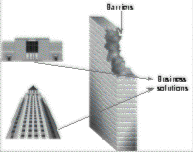
“A truly enabling technology” summarizes my thoughts about thin-client/server computing, a computing model that allows information to be available anywhere at any time, regardless of computing device or connection. Thin-client/server computing will significantly impact the ability of businesses, small and large, to implement new computing solutions at a rapid pace and at lower costs than ever before.
Thin-client/server computing can accelerate access to computer solutions.
Nevertheless, this implementation can pose some challenges. All organizations experience variations of the same implementation problems. These problems can be categorized into management, access, performance, and security issues. For example, let’s look at a hypothetical small business—Adventure Works—that has about 20 employees. The business decision makers see Adventure Works as too small to need an IS department. The organization purchased computers when such purchases seemed necessary, along with off-the-shelf software, which nobody learned to use to its fullest potential. Recently business has taken off, and Adventure Works’ employees barely have time to keep the products flowing to customers, let alone update their computing systems. New computers were purchased as they were needed, without following any cohesive plan. Furthermore, Adventure Works’ The Future of Thin-Client/Server Computing remote sales force, consisting of 10 people located in different parts of the United States, can barely get access to the information they need because downloads are too slow and the system wasn’t designed for the workload.
Adventure Works would greatly benefit from implementing a thin-client/server solution. With such a solution, the organization could leverage its existing hardware, bring its implementations of business software solutions up-to-date, and make information readily available to its sales force as well as to its customers. Rather than invest in an IS department, Adventure Works would be wise to save costs and outsource its IS function to another organization that would effectively provide remote administration, support, and training. The thin-client/server solution would allow the original small (and growing) company to comfortably accelerate its growth.
Larger companies face similar issues—on a grander scale—to those mentioned in the above scenario. They need solutions that can facilitate business growth. Thin-client/server solutions can help large companies achieve these solutions by addressing the management, access, performance, and security aspects of computing while conserving resources. (See Figure 9-1.)
FIGURE 9-1
With thin-client/server technology, management, access, performance, and security barriers will crumble and allow businesses access to solutions.

Government, nonprofit, health, and educational institutions can also benefit tremendously from thin-client/server technology. (Refer to the case studies in Chapter 8 to see how thin-client/server technology has helped companies, organizations, and educational institutions revitalize their ways of doing business.) Computing issues of management, access, performance, and security are as pervasive to these organizations as they are to any large or small business. In some ways, because of constantly constrained and changing budgets, institutional hardware and personnel issues can more intensely impact these types of organizations than they affect typical small businesses. Sooner or later, every organization that uses computers bumps up against the same software issues, not to mention the complexity issues that are created by adding the newest hardware and software to the equation.
In this chapter, I’ll briefly discuss some of the products that are currently being developed by Microsoft Corporation and Citrix Systems. I’ll also talk about the potential impact of thin-client/server solutions on today’s computing world. In the last part of the chapter, I’ll stretch your imagination even further and look at how this technology might bring computing resources to new markets that, while ready and willing, were previously unable to use such solutions.